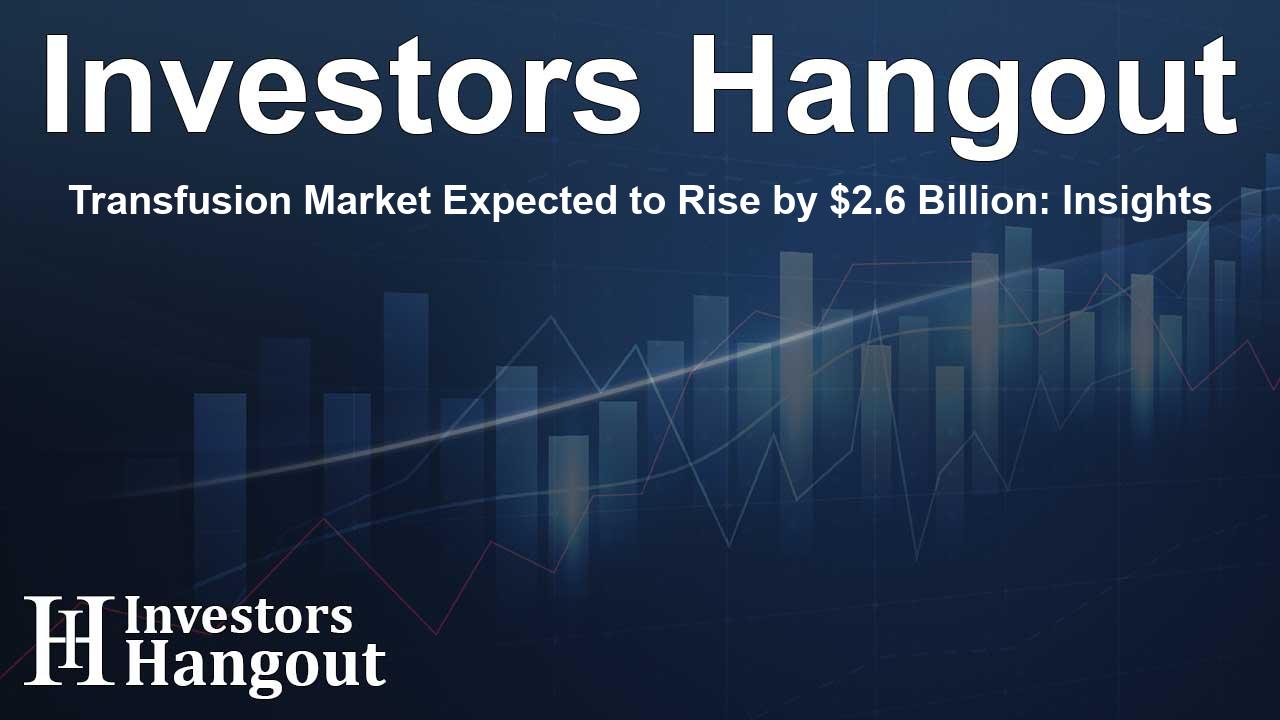Transfusion Market Expected to Rise by $2.6 Billion: Insights

Transfusion Market Expected to Rise by $2.6 Billion
The global blood market is poised for significant expansion, anticipated to grow by USD 2.6 billion between 2024 and 2028, according to recent market analysis. A compound annual growth rate (CAGR) of 5.94% reflects the rising demand for blood and its components, spurred by an increasing number of hospitals and blood banks, and growing awareness of the importance of blood donation. This growth trend is shaping the future of healthcare as innovative practices take center stage in hospitals and blood procurement facilities.
Market Dynamics and Drivers
Several factors are driving the expansion of the blood market. A crucial aspect is the increasing incidence of chronic medical conditions such as leukemia, cancer, and anemia which often require blood transfusions. The demand for body fluids, including red blood cells and plasma, is soaring as the healthcare sector aims to address these growing medical needs. Additionally, the report highlights an uptick in advanced blood testing procedures that enhance patient outcomes, particularly in emergency situations.
Changing Perceptions and Community Engagement
In recent years, there has been a substantial shift in public perception regarding blood donation. Educational campaigns run by government organizations and non-profits have effectively addressed misconceptions surrounding blood donation, leading to increased participation. Blood donation camps have become commonplace, especially in developed countries, where they play a significant role in collecting blood, consequently reinforcing healthy blood supply systems.
Challenges in the Blood Market
Despite the optimistic outlook, the blood market grapples with a set of notable challenges. A primary concern is the low availability of blood storage and transfusion facilities in rural areas. These regions often lack the necessary infrastructure and face financial limitations, resulting in lower demand for blood-related healthcare services. This gap necessitates innovative solutions to ensure a consistent blood supply and access for patients in underserved areas.
Technological Innovations and Their Impact
The blood industry is undergoing a transformation, with technological advancements playing a pivotal role. The introduction of AI-driven solutions has optimized blood collection and processing methods, enhancing efficiency and safety. These technologies enable healthcare professionals to better manage blood resources, minimizing waste and ensuring the highest standards of care are met.
Market Segmentation Overview
The blood market can be segmented into various categories, providing insights into the specific areas contributing to growth. These include:
- Product: Whole blood collection and processing, blood screening products, blood typing products, and source plasma collection.
- End-user: Mainly hospitals, ambulatory surgical centers, and other healthcare facilities.
- Geography: Significant regions include North America, Asia, Europe, and other parts of the world.
The Role of Hospitals and Healthcare Providers
Hospitals and surgical centers are central to the growth of the blood market. They rely on a steady supply of donated blood and plasma for various medical interventions ranging from surgeries to emergency responses. By ensuring that adequate blood supplies are available and that screening processes are reliable, healthcare providers play a crucial role in patient care and safety.
Future Outlook for the Blood Market
The future of the blood market looks promising, driven by an increase in healthcare expenditure and advances in medical technology. The integration of artificial intelligence and data analytics is expected to streamline operations and enhance overall efficiency in blood banks and hospitals. Additionally, as public awareness grows, more individuals are likely to participate in blood donation, further bolstering the availability of this essential resource.
Frequently Asked Questions
1. What is driving the growth of the blood market?
The growth is driven primarily by an increase in chronic medical conditions requiring blood transfusions and a rising number of blood banks and hospitals.
2. How much is the blood market expected to grow?
It is estimated to grow by USD 2.6 billion from 2024 to 2028.
3. What challenges does the blood market face?
The market faces challenges like limited storage and transfusion facilities in rural areas and rising healthcare demands.
4. How is technology affecting the blood market?
Technological advancements, especially AI, are improving blood collection and processing efficiency, leading to better resource management.
5. What is the role of awareness campaigns in blood donation?
Awareness campaigns have significantly improved public perception and increased participation in blood donation initiatives.
About The Author
Contact Dominic Sanders privately here. Or send an email with ATTN: Dominic Sanders as the subject to contact@investorshangout.com.
About Investors Hangout
Investors Hangout is a leading online stock forum for financial discussion and learning, offering a wide range of free tools and resources. It draws in traders of all levels, who exchange market knowledge, investigate trading tactics, and keep an eye on industry developments in real time. Featuring financial articles, stock message boards, quotes, charts, company profiles, and live news updates. Through cooperative learning and a wealth of informational resources, it helps users from novices creating their first portfolios to experts honing their techniques. Join Investors Hangout today: https://investorshangout.com/
The content of this article is based on factual, publicly available information and does not represent legal, financial, or investment advice. Investors Hangout does not offer financial advice, and the author is not a licensed financial advisor. Consult a qualified advisor before making any financial or investment decisions based on this article. This article should not be considered advice to purchase, sell, or hold any securities or other investments. If any of the material provided here is inaccurate, please contact us for corrections.
